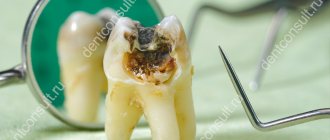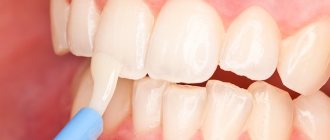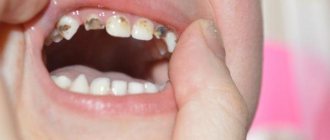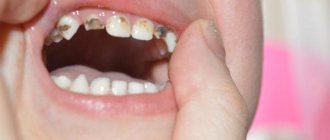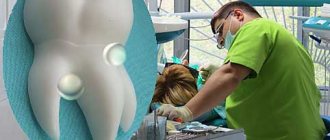Deep fluoridation is a new effective method of fluoridation of teeth used in modern dentistry. This procedure allows you to keep your teeth in a beautiful and healthy condition. The procedure can be performed on both adults and children. In practice, this procedure is used very often and the results obtained clearly demonstrate the reliability and effectiveness of this method.
It is recommended to regularly carry out deep fluoridation of teeth, as this procedure increases the strength and strength of teeth and has not only therapeutic, but also preventive value. A damaged tooth can no longer be restored, it is better to perform prevention!
Deep fluoridation of teeth, unlike the conventional fluoridation procedure, is carried out with a special sealing solution that penetrates deeply into the tooth enamel and remains there in the form of calcium fluoride deposits. This effect of a fluoride-containing substance deep in the tooth enamel is much more effective than simple surface treatment of teeth with conventional fluoridation.
Why is fluoridation necessary for children?
The body in childhood experiences fluoride deficiency. The main factors influencing this are:
- Genetic predisposition.
- General condition of the body. For example, some diseases increase the lack of fluoride, and teeth weaken.
- Poor nutrition.
- Lack of normal child development.
| Due to the factors listed above, tooth enamel weakens and they become sensitive to any changes. The child feels pain when drinking cold or hot drinks or food. Without fluoride, enamel is destroyed and teeth become vulnerable to disease. If caries begins to develop in childhood, there is a high probability that by the age of 30 a person will be missing at least several teeth. Deep fluoridation is an effective preventive measure that increases the resistance of teeth to negative external influences. The risk of disease is reduced many times over. Fluoridation is especially effective when combined with proper hygiene. The child should visit the dentist regularly, use safe brushes and toothpaste recommended by the doctor. |
What is fluoridation?
This is a preventative measure to prevent the development of caries. The essence of prevention is to apply various preparations to the enamel in the form of solutions, gels or varnishes containing fluorine and calcium. This procedure is performed for both children and adults. Its main goal is to strengthen the structure of the enamel and saturate it with necessary minerals. Parents need to understand that this is a preventive measure and not a treatment for caries.
Indications
All of the following signs, except for the last point, can “speak” of a lack of fluoride in the body, and are the basis for the procedure:
- increased sensitivity of teeth;
- presence of cracks and small chips;
- demineralization of enamel (white spots);
- orthodontic treatment (braces).
Contraindications
The procedure is not recommended if the patient is diagnosed with:
- enamel fluorosis (excess fluoride in the body);
- clearly formed dental caries.
Here it is necessary to note one very important point: the cause of diseases such as caries and fluorosis is one – fluoride. The only significant difference is that in the first case this is the result of a fluoride deficiency, and in the second - its excess, which manifests itself evenly on all teeth, in the form of multiple pigment spots.
Indications and contraindications
Deep fluoridation can be carried out from early childhood (from one and a half years). Contraindications
minimum:
|
|
Indications
There is much more to applying the method:
|
|
|
|
|
|
Operating principle
The fluoridation process involves treating the surface with special-purpose preparations. A layer of a compound that releases a large amount of fluoride is applied to the enamel. Upon contact with teeth, crystalline calcium fluoride is formed, which protects against tissue destruction, calcium formation and strengthens enamel.
Deep fluoridation of teeth in children has the following advantages:
- protection of tissues from the development of caries;
- the procedure is painless and does not cause discomfort or pain to the baby;
- prevention can be started from an early age;
- unlike silvering, the enamel surface remains light and does not darken;
- tissue strength increases, excessive sensitivity disappears;
- the service life of existing fillings is extended, and the tissues are additionally protected from damage if the child wears corrective devices.
The disadvantages of performing the procedure include:
- fluoridation must be carried out regularly;
- an excess of this element is harmful to the child’s body; strengthening can be carried out only according to indications;
- In case of severe caries and a number of other damages, such manipulations are not performed.
How is the procedure done?
Deep fluoridation
It is carried out only in a dental office using special preparations.
The procedure requires minimal preparation. It can be divided into five quick stages
:
- Teeth cleaning. Usually a special paste is used to prepare for fluoridation. But if the child has heavy plaque, another cleaning method is chosen.
- Drying the surface of the teeth.
- “Sealing” the enamel. The doctor applies a drug based on magnesium and calcium (fluorides).
- Second drying of the surface of the teeth.
- Application of the final preparation. Dental clinics use a solution of copper and calcium hydroxide.
| After the procedure, both applied layers react. All components gradually penetrate deep into the tooth, significantly enhancing its mineral structure. An important advantage of deep fluoridation is durability. Components applied to the surface are not washed out and are not affected by food or water. |
Fluoridation methods
There are two ways to carry out this preventive procedure. In both cases, the preparatory stage is professional teeth cleaning - this is a necessary and mandatory condition. So, fluoridation happens:
1. Simple. The procedure includes the following manipulations:
- coating of tooth enamel with fluoride varnish;
- installation of individual trays filled with a special gel.
In both cases, the time required for prophylaxis does not exceed 10-15 minutes.
2. Deep. It involves layer-by-layer application of two drugs, which provides a longer-term effect. This method requires slightly more time than in the first case.
Advantages of fluoridation compared to silver plating
Previously, silver plating was used as a preventative measure. But most leading dental clinics abandoned it in favor of deep fluoridation. Here are the reasons:
|
Dentists speak flatteringly about the deep fluoridation procedure. In an interview with the newspaper “Arguments and Facts”, maxillofacial surgeon David Grigoryan Fr.
You can carry out deep fluoridation at our Nikadent clinic in Mytishchi. The cost of the service is quite affordable - about 2.5 thousand rubles. This price includes: professional consultation, preparation, cleaning of tartar, drying of teeth, application of fluoride.
Types of fluoridation
Simple
A fairly effective way to prevent caries. A special composition is applied to the teeth in the form of a thin film, which is not felt at all and lasts up to 6 months.
Glubokoe
The method is used when the integrity of the enamel is damaged. It involves the use of compounds containing, in addition to fluorine, calcium and other minerals. Such compositions are built into the structure of tooth enamel. The effect of the procedure lasts for a year.
Before the procedure, the patient visits a hygienist. The specialist carries out a comprehensive cleaning of teeth, freeing them from bacterial plaque. This will allow the mineral ions to freely penetrate the enamel and do their work.
The procedure is carried out in three stages.
- Drying. The composition is applied to teeth dried from saliva.
- Application. The medicine is evenly distributed over the surface of the teeth, left for 5–7 minutes, after which the teeth are dried again.
- Finishing processing. To consolidate the effect, a concentrated mineral composition is applied to the teeth.
Prices for pediatric dentistry
| Child therapy | |
| Children's professional oral hygiene | 2,200 rub. |
| Filling teeth with glass ionomer cement (Fuji, Vitremer) | 1,500 rub. |
| Dental treatment using vital amputation in one visit (excluding anesthesia) | 3,600 rub. |
| Seal “Dyract” | 2,200 rub. |
| Pulp amputation with placement of a therapeutic bandage | 1,200 rub. |
| Mechanical and medicinal treatment of carious cavity | 500 rub. |
| Application of devitalizing paste | 500 rub. |
| Deep fluoridation of all teeth | 2,500 rub. |
| Carrying out the resorcinol-formalin method (one session) | 700 rub. |
| Filling root canals with paste (one canal) | 300 rub. |
| Carrying out the method of silvering baby teeth (one tooth) | 200 rub. |
| Application of medicinal paste “Pulpotek” | 1,000 rub. |
| Temporary chemical filling | 300 rub. |
Varieties
Strengthening the enamel with fluoride helps protect it. Therefore, to achieve a long-lasting effect, two types were developed:
- ordinary or simple;
- deep.
The choice of one method or another depends on the degree of change in the enamel. Before the procedure itself, the doctor always evaluates the condition of the oral cavity and dentition. Based on this, recommendations are formed.
Simple and deep fluoridation
Simple fluoridation is periodic in nature. Regular replenishment of the deficiencies of the fluorine compound is required. To do this, the doctor makes an individual impression for the patient. It is something like a reservoir. It contains a special gel. This design is applied to the teeth for 20 minutes. The duration of the entire preventive course is 10 sessions.
For simple fluoridation, varnish containing this substance is also used. It is applied to the entire surface using a special brush. The duration of this type of simple fluoridation is about 3 times a month.
Deep is often used by pediatric dentists. Since repeated procedures are not required. This method has a number of advantages:
- reserves of fluorine compounds are formed inside the tooth;
- the strength of the enamel increases several times.
The price for fluoridation of teeth is affordable, and it is carried out for everyone.
Stages of deep fluoridation
To carry out the manipulation, professional cleaning of plaque and stones should be carried out. This is necessary to increase the surface of the tooth capable of interacting with fluoride. The procedure itself consists of several stages:
- First, in dentistry, the oral cavity is dried using air;
- a special substance is applied to the surface that seals it;
- after 3 minutes, use air again to dry again;
- then a solution of copper and calcium hydroxide is applied;
- The last step is rinsing the mouth.
In this form, a chemical reaction occurs. As a result, a precipitate forms in the form of hydroxyapatite. Against this background, fluoride compounds grow more intensively, which begin to fill defects on the surface. Fluorides themselves remain deep in the tooth for a long time, from several months to 2 years.
Deep fluoridation of teeth contributes not only to the restoration of enamel, but also to the formation of a bactericidal effect due to copper ions. After such a complex, only positive reviews remain.
Indications and contraindications
When performing manipulations, they rely on a list of indications. These include:
- thinned enamel;
- caries in the spot stage, when only the enamel is affected;
- increased tooth sensitivity;
- as a method of restoring enamel after chemical bleaching or cleaning.
After the procedure and before it, you should avoid fluoride-containing toothpastes. This can lead to oversaturation and the development of fluorosis.
Despite the great advantages of this method, there are also contraindications. First of all, this is an allergy to the components of the fluoridation complex and the presence of fluorosis.
Positive and negative sides
Tooth enamel should be fluoridated to reduce the risk of developing carious lesions. The positive aspects, in addition, are the following:
- a protective barrier is formed between oral bacteria and tooth enamel;
- fluoridation also protects dentin;
- a big plus is the presence of long-lasting action;
- the risk of the formation of secondary foci of caries in filled teeth is reduced.
Teeth fluoridation before and after: the photo shows how the fluoride complex fills cracks in the enamel and actively fights caries at the stain stage.
The only downside to this method of strengthening enamel is the price. But it is much lower than carrying out a number of therapeutic measures to eliminate caries, pulpitis or periodontitis. Therefore, it is necessary to prevent the occurrence of carious lesions.
The Department of Aesthetic Dentistry offers all types of dental fluoridation for both adults and children. Specialists with extensive experience conduct the necessary examination and recommend the necessary method of strengthening your enamel.

